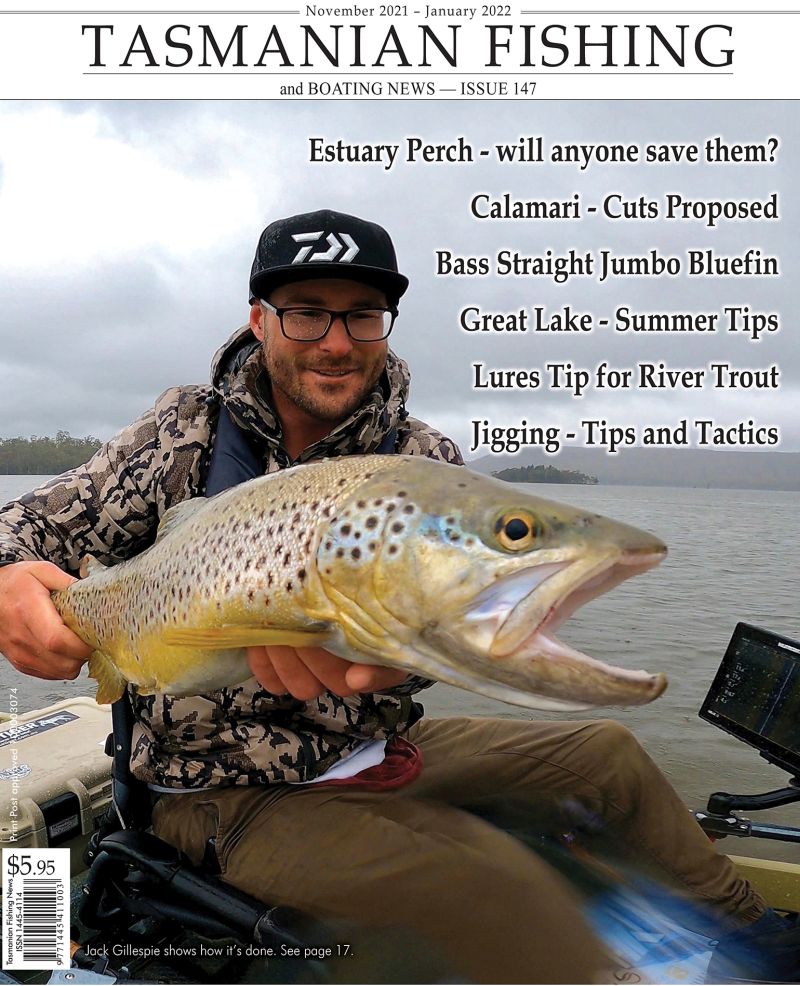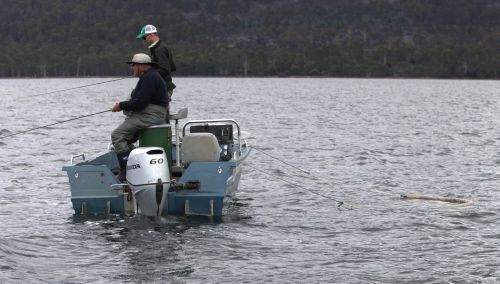Shore Based – St Helens
The St Helens area offers anglers a real variety of fishing options for those possessing a boat or kayak, Georges Bay, Scamander River, Ansons Bay and various coastal Lagoons are all easily accessed by watercraft. However the angler on foot is often left standing wondering where to go and what to do as the boats motor off in the distance. But there are options for the walking fisherman to target and enjoy some great sports fish.
Most Tasmanian anglers are well aware of the quality and size of the Australian salmon and yellowtail kingfish that are available in Georges Bay, but accessing these fish from the shoreline is sometimes seemingly impossible. However there are a couple of areas and techniques that will allow shore based anglers a chance of tackling these wonderful fish.
Many of the schools of Australian salmon, often with small yellowtail kingfish mixed in, will hold up throughout the bay. They can be seen way out in the middle smashing up the surface chasing baitfish but quite often the large schools of salmon will move in and out of the bay and school up inside the Barway. Its when they move backward and forward like this that the shore based angler can take advantage of a small but productive window.
The fish will generally follow the tide so as the tide turns and makes the run out it takes a host of food items and bait fish with it and the salmon will often follow. There are a number of areas that the shore based angler can target the salmon but the high tide limits these a little bit and as the tide recedes more area is available to the angler, also concentrating the fish.
The first and probably most productive area is Dora Point; this is the northern point of the channel as it leaves the Georges Bay and heads over the Barway. Here there is a top class rocky point with easy access and big rock areas protected from waves and spray to store extra gear carried down. The rocks give easy casting straight into relatively deep water running right at the base of the rocks and out to the middle of the channel. On the ocean side of this point is a great little beach that has the channel running almost parallel with it that often has good salmon and kingfish schools sitting within casting distance off the beach. As the tide flows out and drops away more sand on this beach is exposed and the angler is able to walk out closer to the edge of the channel and cast straight into much deeper water, this is where a lot of the salmon will hold just over the edge of the drop waiting to ambush any baitfish forced out of the shallower water.
With the tide now much lower another very productive area is also revealed and this is on the inside of Dora Point, by driving to the end of the track past all the camp grounds and walking down the short track through the coastal scrub there is a large sandy spit exposed at low tide that gives access right to the edge of the channel leading out of the bay toward Dora Point. This area can quite easily be fished even without the need for wading and straight into relatively deep water. Quite often through this area large schools of fish will hold up waiting for the tide to move back in bringing with it fresh ocean water and more food and baitfish. But salmon are not the only species available along here, big silver trevally are regularly caught here with the use of soft plastic lures.
I consider the northern side of the channel to be the pick of the areas, it gives a wide range of choices depending on whether you like to fish the more ocean side off rocks or the more sheltered water off the sand inside the point however the southern side of the channel also offers some options. The Break Wall at Blanches Point looks like it would be a fish magnet but unfortunately this is not always the case, as the current moves very fast along the wall on either the incoming or outgoing tide schools of fish tend to move by quickly not holding station where it would be easy for anglers to target them.
The very end of the wall however can be a different story, as the water movement here tends to eddy and be turbulent if offers some protection for schools of bait fish and mackerel out of the main current. The salmon and more importantly the yellowtail kingfish know this and can often be seen smashing the bait within easy casting distance to the angler. The trick here is to fish right at the very end of the wall and cast into the turbulent water and any water that may be stirred up by wave action.
Another area that can be targeted, although a little more difficult to access, is the southern side of the channel on the inside of the Breakwall at Blanches Point. Here you will need to park in the Blanche Point carpark and walk along the overgrown track to the edge of the sand dune bank looking down over the channel. This can only be accessed at low tide and you will need to scramble down the bank using the old makeshift ladder which can be hairy when carrying good quality fishing tackle and a bag of gear. Once down by the channel edge you can walk for quite a distance back down the channel towards the bay and fish the edge the whole way. Along here you have a good chance of also picking up big silver trevally as well as any salmon or kingfish that may be moving in and out. Be warned though that this area is alive with toad fish and leatherjacket that will have you chewing through bags of soft plastic lures at an alarming rate. (Daniel Paull also has good success here. See the following story)
Tackle & Techniques
To effectively fish these areas I highly recommend the use of lures over bait, either soft plastic lures, metal casting lures or some of the new style of weighted hard body bibbed lures. I say that because of two reasons, number one leaving the bait behind makes it easier to move around from spot to spot as you don’t need to carry buckets or packets of messy bait in some type of storage container separate from everything else. Number two when using bait you tend to attract a lot of the less desirable and rubbish fish that would normally not be targeted with lures.
Metal casting lures such as Halco Twisty’s and Slices, Norstream Sluk Lures, Asari Mahi lures or my favourite the Spanyid Raider and Sniper Lures. All of these lures come in a variety of sizes usually ranging from 10gm right through to 60gm to suit whatever conditions the angler is presented with. The metal lures are used more to target the salmon and the kingfish, both of these fish are high speed swimmers so retrieves need to be the same. The technique is to cast as far as possible, let the lure sink for a few seconds or longer depending on the water depth and where the fish are so mix up the depths a little, and then wind quickly, even as fast as you can wind as believe me you will never out wind a salmon or kingie. The faster you wind the more aggressive the fish will be and so will the strike.
The soft plastics can be fished in a similar manner however you may not achieve the same casting distances as you will with the metal lures. Plastics such as Squidgy Flick baits in 85mm and 110mm and DOA 4” Jerk Baits are ideal and used with jighead weights anywhere from 1/12thoz right through to 1/4oz depending on conditions. The plastics can be fished a couple of different ways, either letting them sink deeper in the water column and twitching them back if the fish are down deep, erratic jerky retrieves through mid water or like the metal lures fast retrieves across the surface or just below the surface. What the plastics lack in their ability to be cast long distances they make up for in versatility when it comes to retrieves.
The final style of lure that I am very impressed with and is producing great catches of salmon as I write this article is the new Maria Duplex series of bibbed hard body lures from Japan. Traditionally bibbed lures are very light and difficult to cast with all but the lightest of casting rods designed for chasing bream and trout, no match for trying to cover distances and target larger fish. However Maria have developed a casting lure designed for just the purpose of chasing salmon, kingfish and small tuna from shore, they are a bibbed lure like a Rapala, come in 2 sizes a 65 mm that weighs 18 gm and a 80 mm that weighs 31 gm allowing them to be cast great distances with more chance of a strike. The Duplex has an excellent wobble and roll action and works well with a high speed retrieving. It is also very effective fished from the beach, it is a sinking lure and it will easily reach the bottom and fished back with an erratic retrieve. The Duplex comes with Owner ST-46 #5 trebles.
Rods should be 7-8 foot in length and in the 2-5kg or slightly larger weight category, graphite preferably as they offer lightness and strength as well as the ability to cast the lures being used. Reels in the 2500 to 4000 size are perfect, stick with quality brands such as Shimano ect as they will offer good warranty periods and high quality components and drags capable of handling bigger fish. For spinning I highly recommend a good braided line, 8-10lb braid should do the job nicely and one of my favourites is the Power Pro brand, its one of the thinnest on the market and also one of the strongest.
Being limited to shore fishing doesn’t mean you have to miss out on quality fishing and some good fish are regularly caught form the areas mentioned above so don’t be frightened to give it a shot.
Jamie Henderson




